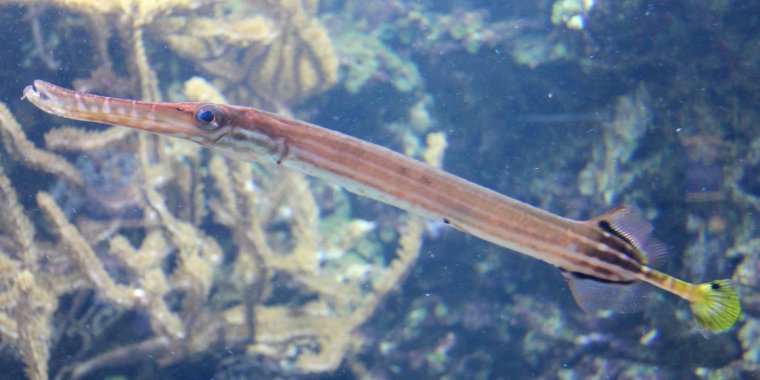| News / Science News |
Stealth swimmers: fish hide behind others to hunt
A new study provides the first experimental evidence that the trumpetfish, Aulostomus maculatus, can conceal itself by swimming closely behind another fish while hunting – and reduce the likelihood of being detected by its prey.

Aulostomus maculatus. Photo: Colling-architektur/Wikimedia Commons
In this ‘shadowing’ behaviour, the long, thin trumpetfish uses a non-threatening species of fish, such as parrotfish, as camouflage to get closer to its dinner.
This is the only known example of one non-human animal using another as a form of concealment.
“When a trumpetfish swims closely alongside another species of fish, it’s either hidden from its prey entirely, or seen but not recognised as a predator because the shape is different,” said Dr Sam Matchette, a researcher in the University of Cambridge’s Department of Zoology and first author of the study.
Damselfish, Stegastes partitus, form colonies on the seafloor and are a common meal for trumpetfish.
Working amongst the coral reefs off the Dutch Caribbean island of Curaçao, researchers set up an underwater system to pull 3D-printed models of trumpetfish on nylon lines past colonies of damselfish, and filmed their responses.
When the trumpetfish model moved past alone, damselfish swam up to inspect - and rapidly fled back to shelter in response to the predatory threat.
When a model of a herbivorous parrotfish, Sparisoma viride, moved past alone, the damselfish inspected and responded far less.
When a trumpetfish model was attached to the side of a parrotfish model – to replicate the shadowing behaviour of the real trumpetfish – the damselfish responded just as they had to the parrotfish model alone: they had not detected the threat.
Trumpetfish are commonly seen swimming alongside parrotfish and other reef fish – but the reason for this remarkable behaviour had not been tested.
“The shadowing behaviour of the trumpetfish appears a useful strategy to improve its hunting success. We might see this behaviour becoming more common in the future as fewer structures on the reef are available for them to hide behind,” said Dr James Herbert-Read in the University of Cambridge’s Department of Zoology, senior author of the study.
YOU MAY ALSO LIKE





